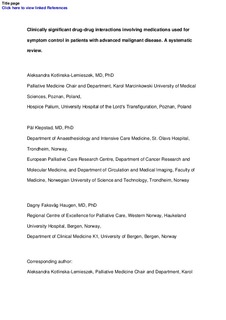| dc.description.abstract | Context
Most patients with advanced malignant disease need to take several drugs to control symptoms. This treatment raises risks of serious adverse effects and drug-drug interactions (DDIs).
Objectives
To identify studies reporting clinically significant DDIs involving medications used for symptom control, other than opioids used for pain management, in adult patients with advanced malignant disease.
Methods
Systematic review with searches in Embase, MEDLINE, and the Cochrane Central Register of Controlled Trials, from the start of the databases (Embase from 1980) through June 21, 2018. In addition, reference lists of relevant full-text articles were hand-searched.
Results
Of 9699 retrieved citations, 462 were considered potentially eligible. After full-text reading, 29 were included in the final analysis, together with 13 articles from reference lists. The 42 included publications were case reports, letters to the Editor, and one retrospective study. Drugs most often involved were antiepileptics, antidepressants, corticosteroids, and nonopioid analgesics. Clinical manifestations of identified DDIs included sedation, respiratory depression, serotonin syndrome, neuroleptic malignant syndrome, delirium, seizures, ataxia, liver and kidney failure, bleeding, cardiac arrhythmias, rhabdomyolysis, and others. The most common mechanisms eliciting DDIs were alteration of CYP450-dependent metabolism and overstimulation of serotonin receptors in the central nervous system.
Conclusion
Drugs used for symptom control in patients with advanced cancer may cause serious DDIs. Although there is limited evidence for the risk of clinically significant DDIs, physicians treating patients with cancer should try to limit polypharmacy, avoid drug combinations with a high risk of DDIs, and closely monitor patients for adverse drug reactions. | nb_NO |

